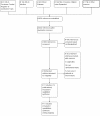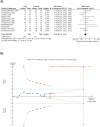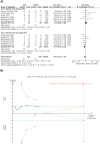The Effects of Intravenous Immunoglobulins in Women with Recurrent Miscarriages: A Systematic Review of Randomised Trials with Meta-Analyses and Trial Sequential Analyses Including Individual Patient Data
- PMID: 26517123
- PMCID: PMC4627734
- DOI: 10.1371/journal.pone.0141588
The Effects of Intravenous Immunoglobulins in Women with Recurrent Miscarriages: A Systematic Review of Randomised Trials with Meta-Analyses and Trial Sequential Analyses Including Individual Patient Data
Abstract
Background: Immunological disturbances are hypothesised to play a role in recurrent miscarriage (RM) and therefore intravenous immunoglubulins (IVIg) have been tested in RM patients.
Objectives: The objectives were to investigate the benefits and harms of IVIg versus placebo, no intervention, or treatment as usual in women with RM.
Search strategy: We searched the published literature in all relevant databases.
Selection criteria: Randomised trials investigating IVIg versus placebo, no intervention, or treatment as usual in women with RM.
Data collection and analysis: We undertook meta-analyses of aggregated data and individual patient data using a two-step approach, and we conducted bias domain assessments and trial sequential analyses to assess the risks of systematic and random errors.
Main results: We identified 11 randomised clinical trials. No significant difference in the frequency of no live birth was found when IVIg was compared with placebo or treatment as usual (RR 0.92, 95% CI 0.75-1.12, p = 0.42). Trial sequential analysis showed that the required information size of 1,008 participants was not obtained. IVIg compared with placebo seems to increase the risk of adverse events. Subgroup analysis suggests that women with RM after a birth (secondary RM) seemed most likely to obtain a potential beneficial effect of IVIg (RR for no live birth 0.77, 95%CI 0.58-1.02, p = 0.06), however, trial sequential analysis showed that insufficient information is presently accrued.
Conclusion: We cannot recommend or refute IVIg in women with RM. IVIg should therefore be assessed in further randomised clinical trials with positive outcomes before any clinical use is considered.
Conflict of interest statement
Figures



References
-
- Rai R, Regan L. Recurrent miscarriage. Lancet. 2006. August 12;368(9535):601–11. - PubMed
-
- Laskin CA, Bombardier C, Hannah ME, Mandel FP, Ritchie JW, Farewell V, et al. Prednisone and aspirin in women with autoantibodies and unexplained recurrent fetal loss. N Engl J Med. 1997;337(3):148–53. - PubMed
-
- Porter TF, LaCoursiere Y, Scott JR. Immunotherapy for recurrent miscarriage. Cochrane Database Syst Rev. 2006(2):CD000112 - PubMed
-
- Christiansen OB, Pedersen B, Rosgaard A, Husth M. A randomized, double-blind, placebo-controlled trial of intravenous immunoglobulin in the prevention of recurrent miscarriage: evidence for a therapeutic effect in women with secondary recurrent miscarriage. Hum Reprod. 2002;17(3):809–16. - PubMed
Publication types
MeSH terms
Substances
LinkOut - more resources
Full Text Sources
Other Literature Sources

